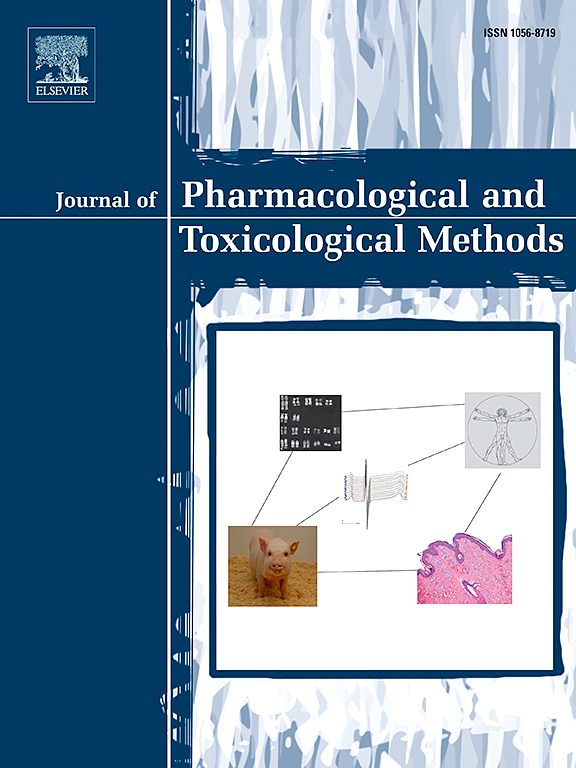Using SPAR to analyze arterial blood pressure waves, following fostamatinib and entospletinib administration in radiotelemetry in rats, to aid in cardiovascular safety testing
IF 1.3
4区 医学
Q4 PHARMACOLOGY & PHARMACY
Journal of pharmacological and toxicological methods
Pub Date : 2025-05-01
DOI:10.1016/j.vascn.2025.107609
引用次数: 0
Abstract
Cardiovascular safety liabilities represent a leading cause of drug attrition, and improved preclinical measurements are essential to predict drug-related toxicities (Cook et al., 2014; Weaver & Valentin, 2019). Presently, radiotelemetry approaches recording blood pressure are routinely used in preclinical in vivo assessments. Typically, single points of these waveforms (e.g. mean arterial pressure (MAP)) are used for analysis. Although MAP provides important insights, this approach overlooks potential information hidden in changes in waveform morphology and variability. The Symmetric Projection Attractor Reconstruction (SPAR) is a novel mathematical method that enables detailed wave analysis, transforming lengthy waveform recordings into contained visual 2D representations (attractors) (Nandi & Aston, 2020). By subsequent analysis of key features of the attractor (e.g. rQ25, indicating the opening of the attractor), subtle changes in the cardiovascular system can be detected. The objective of the present study was to explore in-depth characterization of arterial blood pressure waves after drug administration. Fostamatinib, a Syk-inhibitor causing hypertension due to off-target VEGFR2-inhibition, and entospletinib, designed for better selectivity and less adverse effects, are presented as an example of how in-depth wave analysis could improve cardiovascular safety testing. Male Wistar rats were instrumented with Stellar telemetry implants. Arterial blood pressure was recorded over two consecutive days, for at least 1 h before and up to 23 h after daily administration of fostamatinib (20 mg/kg, p.o.) or entospletinib (6 mg/kg, p.o), alongside a vehicle control (10 mL/kg, p.o.). Fostamatinib increased MAP significantly on day 2 (p < 0.05, Two-way ANOVA); there was no significant effect on MAP on day 1. Entospletinib did not affect MAP significantly. Fostamatinib caused changes in waveform morphology, that were quantified using attractor parameters. Attractor opening increased significantly from day 1 of fostamatinib administration (e.g. rQ25 p < 0.05, Two-way ANOVA). These fostamatinib-induced attractor changes were opposite to the ones observed with vasodilators, associated with a decrease in attractor opening, therefore indicating that fostamatinib caused a vasoconstriction. This is consistent with literature, describing a fostamatinib-induced vasoconstriction due to VEGFR2-inhibition (Skinner et al. 2014). Moreover, entospletinib had similar but smaller effects on attractor opening (delta rQ25 p < 0.0005 on day 1, Two-way ANOVA). Given that SPAR could detect fostamatinib-induced cardiovascular effects earlier than MAP, and SPAR could detect entospletinib-induced changes in a more sensitive way than MAP, these data suggest that more extensive blood pressure waveform analysis using SPAR in telemetered rats may provide nuanced information that could aid in informed decision making and earlier detection of cardiovascular safety liabilities. This work was funded by the European Union's H2020 Research & Innovation Program (GA 858070).
利用SPAR分析大鼠放射遥测给药福司他替尼和托替尼后的动脉血压波,以辅助心血管安全性测试
心血管安全责任是药物损耗的主要原因,改进临床前测量对于预测药物相关毒性至关重要(Cook等人,2014;韦弗,瓦伦汀,2019)。目前,记录血压的无线电遥测方法通常用于临床前体内评估。通常,这些波形的单点(例如平均动脉压(MAP))用于分析。尽管MAP提供了重要的见解,但这种方法忽略了隐藏在波形形态和可变性变化中的潜在信息。对称投影吸引子重建(SPAR)是一种新颖的数学方法,可以进行详细的波分析,将冗长的波形记录转换为包含的可视化二维表示(吸引子)(Nandi &;阿斯顿,2020)。通过对吸引子的关键特征(如rQ25,表示吸引子的开启)的后续分析,可以检测到心血管系统的细微变化。本研究的目的是深入探讨给药后动脉血压波的特征。Fostamatinib是一种syk抑制剂,由于对vegfr2的脱靶抑制而导致高血压,而entospletinib具有更好的选择性和更少的不良反应,这是深度波分析如何改善心血管安全性测试的一个例子。对雄性Wistar大鼠进行恒星遥测植入。在连续两天内记录动脉血压,每日给药福司马替尼(20 mg/kg, p.o.)或托替尼(6 mg/kg, p.o.)之前至少1 h,最多23 h,同时进行车辆对照(10 mL/kg, p.o.)。Fostamatinib在第2天显著增加MAP (p <; 0.05,双向方差分析);第1天对MAP无显著影响。托替尼对MAP无显著影响。Fostamatinib引起波形形态的变化,使用吸引子参数进行量化。福司他替尼给药第1天吸引子开度显著增加(如rQ25 p <; 0.05,双向方差分析)。这些fostamatinib诱导的吸引子变化与血管扩张剂观察到的相反,与吸引子开口减少有关,因此表明fostamatinib引起血管收缩。这与文献描述的由于vegfr2抑制而引起的fostamatinib诱导的血管收缩是一致的(Skinner et al. 2014)。此外,托替尼对吸引子开放也有类似但较小的影响(第1天的δ rQ25 p <; 0.0005,双向方差分析)。鉴于SPAR可以比MAP更早地检测到fostamatinib诱导的心血管效应,并且SPAR可以比MAP更敏感地检测到托斯替尼诱导的变化,这些数据表明,在遥测大鼠中使用SPAR进行更广泛的血压波形分析可能提供细微的信息,有助于知情决策和更早地检测心血管安全责任。这项工作由欧盟的H2020研究资助。创新计划(GA 858070)。
本文章由计算机程序翻译,如有差异,请以英文原文为准。
求助全文
约1分钟内获得全文
求助全文
来源期刊

Journal of pharmacological and toxicological methods
PHARMACOLOGY & PHARMACY-TOXICOLOGY
CiteScore
3.60
自引率
10.50%
发文量
56
审稿时长
26 days
期刊介绍:
Journal of Pharmacological and Toxicological Methods publishes original articles on current methods of investigation used in pharmacology and toxicology. Pharmacology and toxicology are defined in the broadest sense, referring to actions of drugs and chemicals on all living systems. With its international editorial board and noted contributors, Journal of Pharmacological and Toxicological Methods is the leading journal devoted exclusively to experimental procedures used by pharmacologists and toxicologists.
 求助内容:
求助内容: 应助结果提醒方式:
应助结果提醒方式:


